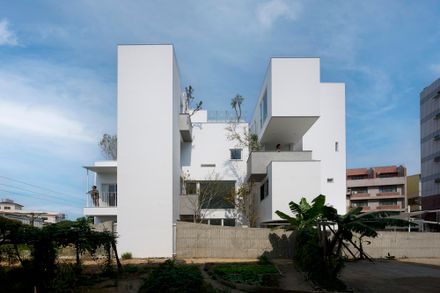ARCHITECTS
Ray Architects, Soar Design Studio
LEAD ARCHITECT
Ray Chang
MANUFACTURERS
Carl Hansen And Son, Muji, Republic Of Fritz Hansen
ARCHITECTURAL DETAIL
Lin Yi-syuan
YEAR
2024
LOCATION
Taichung, Taiwan
CATEGORY
Houses
Text description provided by architect.
The design deconstructs architecture to integrate with nature. Long street houses are transformed into five staggered volumes with gaps between them. Horizontal and vertical planes formulate floors of different levels, allowing for natural elements to get in.
Imagery of valleys is combined with the traditional Taiwanese courtyard, forming the architecture that adapts to wind and sunlight.
THE KEY POINTS OF OUR DESIGN ARE AS FOLLOWS
- Utilizing deconstructive techniques to respond to natural milieu and create favorable microclimates
- Imagery of valleys combined with traditional courtyard, creating a harmony of architecture in nature - In spaces enveloped by nature, one can fully experience the natural elements in the house
The project is situated among the common standalone buildings in Taiwan: on a long and narrow site with windows on the front and back only, and closely attached to the adjacent buildings, resulting in its disconnection from the external environment.
Given the cold and humid northeast wind it faces, the design mitigates the climatic and physical disadvantages for a comfortable living.
The design attempts to propose new solutions for adjacent standalone buildings through "deconstruction," reversing the traditional layout of living spaces placed at both ends of the house.
By inserting gaps and different levels into nature and breaking up the concrete boxes with semi-outdoor spaces, it creates a new urban residential typology and expands the possibility for residents to connect with nature.
DECONSTRUCTING HOUSE ARCHITECTURE
n response to the climate and surrounding physical environment, the standalone building is transformed into five unaligned structures.
The vertical circulation is placed in the first building facing the northeast wind, while the living spaces are pushed backward, reducing the adverse effects of cold wind and humidity. The height of the buildings on the southwest side is reduced to receive the southwest wind.
By narrowing the wind passage and accelerating wind speed, it can penetrate through the courtyard and follow the buildings and trees upwards, or enter the interior through gaps between the buildings.
Thus it creates a favorable indoor microclimate and a comfortable experience. One can fully experience the outdoor nature even staying indoors.
THE EASTERN STYLE OF GARDEN THAT THE SCENERY CHANGES AS ONE MOVES
By merging the imagery of valleys with the traditional concept of a courtyard, the plane receiving wind and human activities is altered vertically.
The gradually receding balconies become valleys for wind, vegetation, and habitats including humans. Indoors, the voids echo the verticality of the valley, allowing for the senses to have a visual connection with nature.
On the plans, recession and excavation create permeable spaces, while nature simultaneously infiltrates indoors through horizontal and vertical dimensions.
This creates a new relationship between architecture and nature, allowing for perspectives from above, below, and at eye level to redefine the living boundaries between indoor and outdoor.
The techniques of deconstruction are for the adaptation to the conditions of the site and to reshape the space for a multi-generational lifestyle.
In deconstructed home architecture, the space is defined by structures, gaps, and outdoor elements to create distances and boundaries.
Users can navigate through the varied spaces and corners generated by the building's unaligned layers to develop different usage and scenarios.
This creates spaces that are conducive for gatherings or by oneself, characterized by a state of being both connected and detached, breaking away from conventional ways of housing and living.
The design attempts to integrate abstract sensibility and nature into the rational composition of architecture.
Service functions are predominantly placed in the 1st and 4th buildings, while the 2nd and 3rd buildings allocate spaces such as tearoom, study, dining area, and reading desks by the windows across different floors.
This weaves the living spaces amidst the service areas, achieving a balanced utilization of the elongated space.
The bedrooms located in the end building can enjoy the comfortable southwest wind privately with an internal valley view.
Various trees are planted on the balconies of different levels, introducing different natural color variations reminiscent of valleys and elucidating the natural flow that arises from the differing heights both indoors and outdoors.































